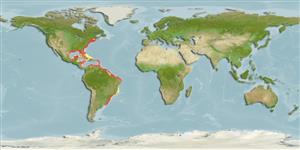Common names from other countries
>
Anguilliformes (Eels and morays) >
Ophichthidae (Snake eels) > Ophichthinae
Etymology: Ophichthus: Greek, ophis = serpent + Greek, ichthys = fish (Ref. 45335); gomesii: Named for Ildefonso Gomes, a physician who treated Castelnau of a sickness in Rio de Haneiro; noun in genetive case (Ref. 54133).
More on author: Castelnau.
Environment: milieu / climate zone / depth range / distribution range
Ecologia
marino demersale; distribuzione batimetrica 1 - 450 m (Ref. 57911), usually 1 - 90 m (Ref. 57911). Tropical; 44°N - 36°S, 98°W - 34°W
Western Atlantic: Massachusetts, USA and northern Gulf of Mexico to southern Brazil; absent in the Bahamas and most Caribbean islands. Northwest Atlantic: Canada (Ref. 5951).
Size / Peso / Age
Maturity: Lm ? range ? - ? cm
Max length : 91.4 cm TL maschio/sesso non determinato; (Ref. 26340); common length : 50.0 cm TL maschio/sesso non determinato; (Ref. 3795)
Inhabits soft bottoms. Occurs in bays and backwaters to offshore banks, less commonly to 180 m depth. The most common eel on Florida shrimp grounds. Rarely consumed (Ref. 3795).
Life cycle and mating behavior
Maturities | Riproduzione | Spawnings | Egg(s) | Fecundities | Larve
Robins, C.R. and G.C. Ray, 1986. A field guide to Atlantic coast fishes of North America. Houghton Mifflin Company, Boston, U.S.A. 354 p. (Ref. 7251)
IUCN Red List Status (Ref. 130435)
CITES (Ref. 128078)
Not Evaluated
Threat to humans
Harmless
Human uses
Pesca: di nessun interesse
Strumenti
Special reports
Download XML
Fonti Internet
Estimates based on models
Preferred temperature (Ref.
115969): 12.4 - 27.8, mean 24.8 (based on 1328 cells).
Phylogenetic diversity index (Ref.
82804): PD
50 = 0.5000 [Uniqueness, from 0.5 = low to 2.0 = high].
Bayesian length-weight: a=0.00089 (0.00039 - 0.00204), b=3.00 (2.80 - 3.20), in cm Total Length, based on LWR estimates for this (Sub)family-body shape (Ref.
93245).
Trophic level (Ref.
69278): 4.0 ±0.7 se; based on size and trophs of closest relatives
Resilienza (Ref.
120179): Medio, tempo minimo di raddoppiamento della popolazione 1.4 - 4.4 anni (Preliminary K or Fecundity.).
Fishing Vulnerability (Ref.
59153): High vulnerability (57 of 100).
